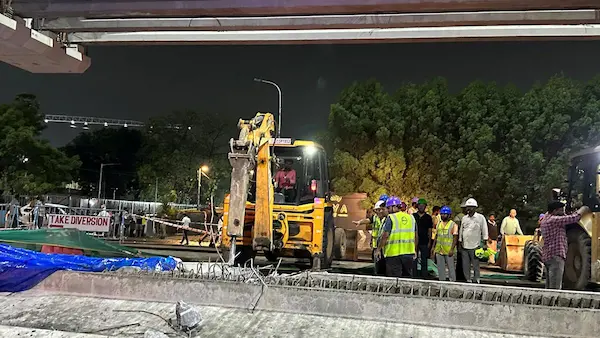
A 43-year-old man lost his life beneath 75 tonnes of steel has left a city in shock
A Life Lost in Seconds: The Night Chennai Stopped Breathing
Chennai Metro Girder Collapse – It was just another evening in Manapakkam. Commuters zipped past the under-construction metro corridor, unaware that two massive I-girders, each weighing nearly 75 tonnes, were moments away from disaster. At 9:45 PM on June 12, 2025, the unthinkable happened. The girders came crashing down, crushing 43-year-old Ramesh, a motorcyclist from Nagercoil, in an instant.
The site, part of Chennai Metro’s ambitious Phase II expansion, turned into a scene of chaos and grief. Emergency crews rushed in, but it was too late. The supports, temporary A-frames and metal buckles had failed catastrophically. What should have been a routine night of construction became a fatal reminder of what happens when safety is sidelined.
The Fallout: Fines, Firings, and a Fractured Trust
In the days that followed, Chennai Metro Rail Limited (CMRL) launched a full-scale investigation. The verdict was swift and damning: Larsen & Toubro (L&T), the project’s main contractor, was primarily responsible for the collapse. The reason? Critical safety measures, like lateral bracing and proper fastening, were either ignored or poorly executed.
CMRL slapped a ₹1 crore fine on L&T. But the accountability didn’t stop there. Four engineers were dismissed from the project, including L&T’s Chief Safety Manager and Senior ESHS Manager, along with two key personnel from the General Consultant team overseeing the site.
To support the grieving family, CMRL offered an ex-gratia payment of ₹5 lakh, while L&T added ₹20 lakh, a gesture that, while necessary, can never replace a life lost to negligence.
Beyond Blame: Can India Build Safer?
This wasn’t just a construction mishap, it was a systemic failure. As India races to modernize its cities, safety often becomes collateral damage in the pursuit of speed and scale. The Chennai Metro collapse has sparked a reckoning.
CMRL has now ordered a comprehensive safety audit across all elevated corridors. Engineers are reinforcing girders, rechecking supports, and reviewing every inch of the project. But the question lingers: why must tragedy be the trigger for reform?
Experts are calling for third-party safety audits, real-time structural monitoring, and legal frameworks that hold corporations criminally liable for gross negligence. Because when a 75-tonne girder falls, it doesn’t just break concrete, it shatters public trust.
Conclusion: Chennai Metro Girder Collapse
The Chennai Metro girder collapse is a haunting reminder that behind every blueprint is a beating heart. Ramesh’s death wasn’t just an accident, it was a failure of systems, oversight, and accountability. As L&T faces penalties and engineers are shown the door, India must ask itself: are we building fast, or are we building right?
Stay updated with the latest news on Rapido Updates. Keep yourself updated with The World, India News, Entertainment, Market, Gadgets, Sports, and many more..
1 thought on “Crushed by Negligence: Chennai Metro Girder Collapse Claims Life, L&T Fined ₹1 Crore in Wake of Tragedy”